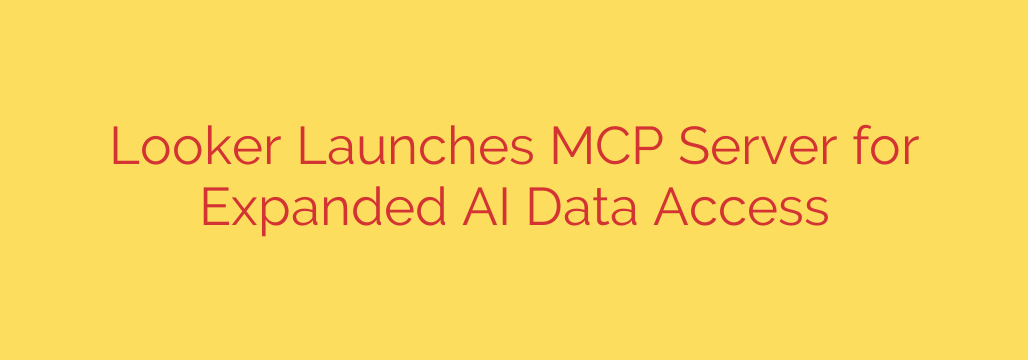
Bridging the Data Divide: How to Unlock AI Potential Across Multiple Clouds
In today’s competitive landscape, artificial intelligence isn’t just a buzzword—it’s a critical engine for growth, innovation, and efficiency. However, even the most advanced AI models are only as good as the data they can access. For most organizations, this presents a massive challenge: valuable data is often fragmented across various cloud platforms like Google Cloud, Amazon Web Services (AWS), and Microsoft Azure.
Traditionally, accessing this siloed data for AI meant building complex, expensive, and slow data pipelines to copy and centralize information. This process not only drains resources but also introduces significant security risks and governance headaches. A new architectural approach is changing this paradigm, allowing businesses to finally connect their AI tools to data, no matter where it resides.
The Core Challenge: AI’s Thirst for Siloed Data
The multi-cloud strategy is a reality for most modern enterprises. You might run your data warehouse on one platform, your marketing applications on another, and your core business software on a third. While this approach offers flexibility, it creates invisible walls between your data assets.
When you want to train a machine learning model or power a generative AI application, you need a complete, holistic view of your business. This requires bringing together data from all these disparate sources. The old solution involved:
- Extract, Transform, Load (ETL): Pulling data from multiple clouds.
- Data Duplication: Creating copies of data in a central repository.
- Increased Complexity: Managing multiple data pipelines and ensuring consistency.
This entire process is a major bottleneck, slowing down innovation and making it difficult for AI to deliver on its promise.
A New Vision: Connecting Data Directly Where It Lives
Instead of moving mountains of data, what if you could create a universal intelligence layer that sits on top of it all? This is the principle behind a modern multi-cloud semantic platform.
At its core, this technology allows a business intelligence (BI) platform to connect to data directly within any major cloud environment. It acts as a smart intermediary, or a “universal translator,” for all your data. When an AI model or a business user asks a question, the platform understands the request, retrieves the necessary data from its original source—be it in AWS, Azure, or Google Cloud—and delivers a unified, coherent answer.
The key breakthrough is that the data itself doesn’t move. It remains securely in its native environment, governed by existing security protocols. This approach effectively creates a single, reliable source of truth for both humans and machines, without the need for costly and risky data replication.
Key Benefits of a Multi-Cloud Connected Architecture
Adopting a strategy that connects AI to governed, multi-cloud data offers transformative advantages for any data-driven organization.
- True Multi-Cloud Analytics: Break down the barriers between your cloud providers. You can now seamlessly analyze data from a Google BigQuery warehouse alongside data from an AWS Redshift cluster, all within a single, consistent framework.
- Enhanced Security and Governance: By leaving data in its source location, you drastically reduce your security exposure. Your data remains protected by its native security controls, and you can manage access through a centralized governance layer. This ensures that only authorized users and applications can query sensitive information.
- Consistent and Trustworthy AI: A universal semantic layer ensures that everyone—from a data scientist training a model to a CEO reviewing a dashboard—is using the same definitions for key business metrics. This eliminates ambiguity and builds trust in your AI-driven insights.
- Reduced Costs and Complexity: Say goodbye to maintaining fragile and expensive ETL pipelines. This streamlined architecture simplifies your data stack, reduces data storage costs, and frees up your engineering teams to focus on innovation instead of data wrangling.
Actionable Tips for Secure AI Data Integration
As you move to connect your AI platforms with a multi-cloud data strategy, keeping security and governance at the forefront is essential.
- Define Your Semantic Model First: Before connecting any tools, work with business stakeholders to define your core metrics and dimensions. What defines a “customer”? How is “revenue” calculated? Establishing this business logic upfront ensures consistency and prevents misinterpretation by AI models.
- Implement Robust Access Controls: Use a platform that allows for granular control over who can see what data. Leverage role-based access controls to ensure that AI models and the teams that manage them only have permission to query the data they absolutely need for their specific function.
- Audit and Monitor All Queries: Maintain a comprehensive log of every query made against your data, whether it comes from a human or an AI. This is critical for security compliance and for understanding how your AI systems are using data, which helps in optimizing performance and troubleshooting issues.
The Future of AI is Connected
The era of being locked into a single cloud ecosystem or being forced to duplicate data to gain insights is coming to an end. The future of business intelligence and artificial intelligence lies in the ability to securely and efficiently access data wherever it lives. By leveraging a universal semantic layer, organizations can finally unleash the full potential of their AI initiatives, driving smarter decisions and creating a true competitive advantage in a data-rich world.
Source: https://cloud.google.com/blog/products/business-intelligence/introducing-looker-mcp-server/








